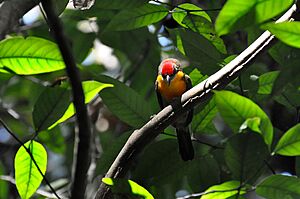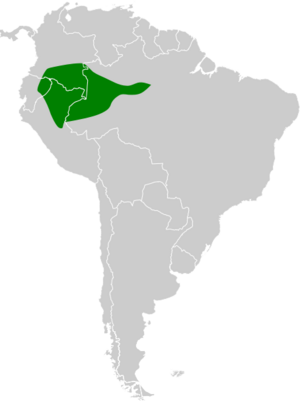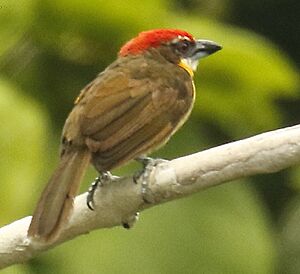Scarlet-crowned barbet facts for kids
Quick facts for kids Scarlet-crowned barbet |
|
|---|---|
 |
|
| Conservation status | |
| Scientific classification | |
| Genus: |
Capito
|
| Species: |
aurovirens
|
 |
|
The scarlet-crowned barbet (scientific name: Capito aurovirens) is a colorful bird that lives in the Amazon rainforest. You can find this bird in parts of Brazil, Colombia, Ecuador, and Peru. It belongs to a group of birds called New World barbets.
About the Scarlet-Crowned Barbet
What Does a Scarlet-Crowned Barbet Look Like?
The scarlet-crowned barbet is about 19 cm (7.5 in) long. That's about the length of a standard pencil! It weighs between 46 to 75 g (1.6 to 2.6 oz), which is like weighing a few strawberries.
Like all barbets, it's a sturdy bird with a strong, thick beak. Both male and female barbets are mostly olive green. They have a light, whitish chin and a bright orange-yellow throat and upper chest.
Differences Between Male and Female Barbets
The male scarlet-crowned barbet has a bright red crown on its head. This red color goes down to the back of its neck. Its lower belly is a mix of olive, gray, and yellow.
The female barbet has a white crown instead of red. This white color fades into olive on the back of her neck. Otherwise, she looks quite similar to the male. Young barbets are a duller olive-gray. They have an olive crown with hints of red or white, depending on if they are male or female.
Where Do Scarlet-Crowned Barbets Live?
These barbets live in the central Amazon Basin. In the western part, they are found near the Andes mountains in southern Colombia, eastern Ecuador, and east-central Peru. To the east and south, they reach the Negro River in northwestern Brazil and other areas in central and west-central Brazil.
They prefer to live in different types of forests, especially those near water. This includes swamp forests, floodplains (called várzea forests), and even forests that are regrowing after being cut down. They can be seen at all levels of the forest, from the ground to the very tops of the trees. They usually live in lowlands, up to about 500 to 600 m (1,600 to 2,000 ft) high in the Andean foothills.
Life and Habits of the Barbet
What Do Scarlet-Crowned Barbets Eat?
While we don't know every detail of their diet, we do know that scarlet-crowned barbets enjoy eating berries, other fruits, and insects. They find their food by looking closely at branches, twigs, leaves, and even clusters of dead leaves. These birds usually hunt for food alone and don't often join large groups of different bird species.
Reproduction and Nesting Habits
Scarlet-crowned barbets can breed almost any time of the year in some part of their range. However, they usually don't breed from September to November.
We don't have a detailed description of their nests yet. But we know that all birds in the barbet family make their nests in tree cavities. They dig out these holes themselves in tree trunks or branches.
How Do Scarlet-Crowned Barbets Communicate?
The song of the scarlet-crowned barbet sounds like a series of low "ttroup" or "ttdoot" notes. They often "countersing," which means two birds sing back and forth to each other. Their other calls are described as sounding "grating-like."
Conservation Status
The IUCN (International Union for Conservation of Nature) has listed the scarlet-crowned barbet as a species of "Least Concern." This means they are not currently in danger of extinction. These birds are fairly common to find and live in several protected areas. They are also good at adapting to changes in their forest homes.



